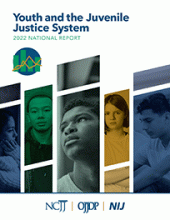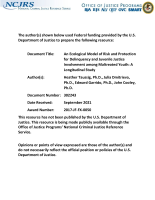Youth involvement
What Should Be Done in the Family to Prevent Gang Membership?
The Influence of Social Surroundings on Juvenile and Criminal Justice Involvement of 17-Year-Olds Transitioning from Foster Care to Adulthood: A Longitudinal and Life-Course Approach
Parenting and Young Adult Crime: The Enduring Effects of Parental Attitudes and Behaviors
Disrupting the Pathways to Gang Violence for Youth of Color
Delinquency Cases Waived to Criminal Court, 2020
Youth Dually-Involved in the child welfare and juvenile justice systems: Varying definitions and their associations with trauma exposure, posttraumatic stress, & offending
Can Law Enforcement Training Address Racial and Ethnic Disproportionality? An Experimental Evaluation of Effective Youth Interactions
Caring Connections for Youth: Evaluation of a Countywide Pre-Arrest Diversion Initiative to Reduce Racial/Ethnic Disparities
Cannabis liberalization policies and trends in cannabis-related school-based discipline: Examining sociodemographic disparities in Massachusetts
National Institute of Justice Fiscal Year 2019 Annual Report
Youth and the Juvenile Justice System: 2022 National Report
A Comprehensive Longitudinal Study of School Violence and the School-to-Prison Pipeline: Root Causes and Consequences of and Implications for Restorative Justice Approaches
Organized Activity Involvement Among Urban Youth: Understanding Family- and Neighborhood- Level Characteristics as Predictors of Involvement
NIJ-Funded Research on Firearms Violence in Urban Cities Advancing Scientific Evidence to Inform Practice
In this full thematic panel, renowned experts will present a series of papers summarizing the newest findings of NIJ-funded research projects on criminal offenses with firearms in urban areas. Researchers used various criminological and other theories, including routine activity theory, socio-ecological and socio-environmental perspectives, and advanced mixed-study methods, including surveys and spatio-temporal designs, to produce scientific evidence to inform practice.
See the YouTube Terms of Service and Google Privacy Policy
Reducing Youth Incarceration for Runaway and Truancy: A National Scan of Practice and Evaluability Assessments in Three Sites
Associations among Trauma Exposure, Callous-Unemotionality, Race or Ethnicity, and Gang Involvement in Justice-Involved Youth
Effectiveness of a social problem solving training in youth in detention or on probation: An RCT and pre-post community implementation
NIJ Funded Research on Firearms Violence in Urban Cities: Advancing Scientific Evidence to Inform Practice
An Ecological Model of Risk and Protection for Delinquency and Juvenile Justice Involvement among Maltreated Youth: A Longitudinal Study
Testing Gender-Differentiated Models of the Mechansms Linking Polyvictimization and Youth Offending Numbing and Callousness Versus Dissociation and Borderline Traits
Dual System Youth: At the Intersection of Child Maltreatment and Delinquency
Across the country, child welfare and juvenile justice systems now recognize that youth involved in both systems (i.e., dual system youth) are a vulnerable population who often go unrecognized because of challenges in information-sharing and cross system collaboration. In light of these challenges, national incidence rates of dual system youth are not known.
See the YouTube Terms of Service and Google Privacy Policy







